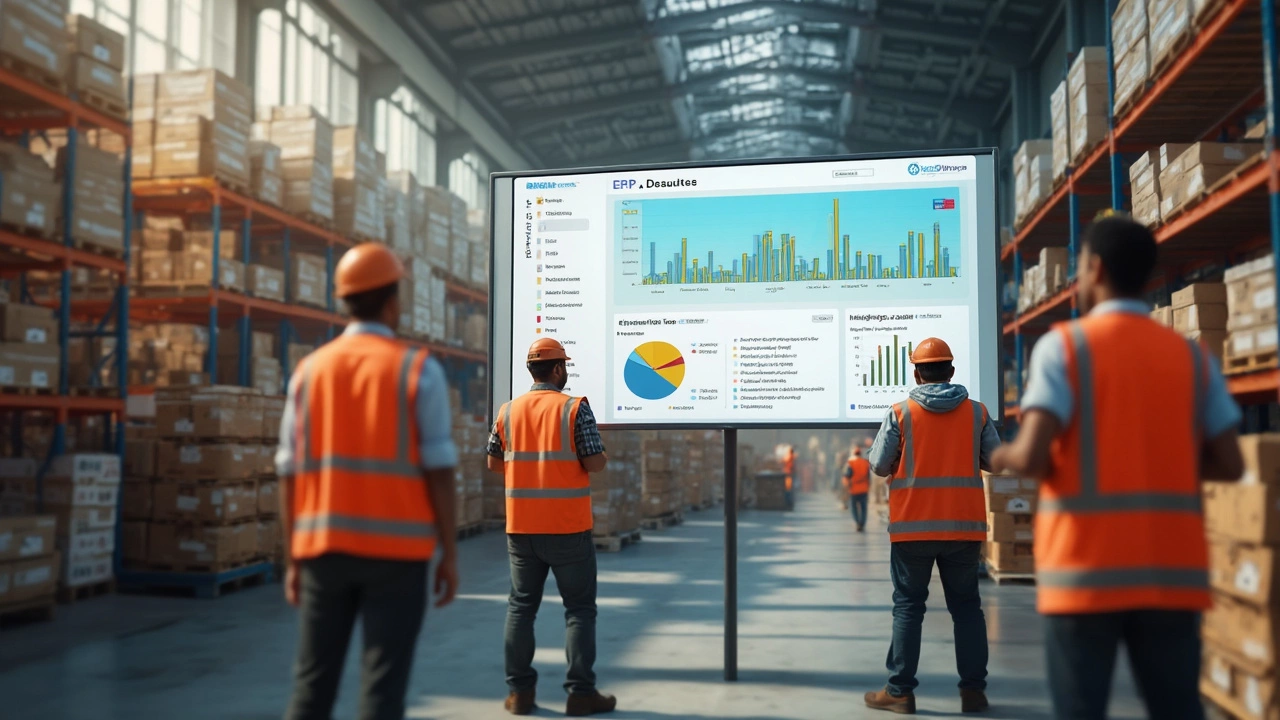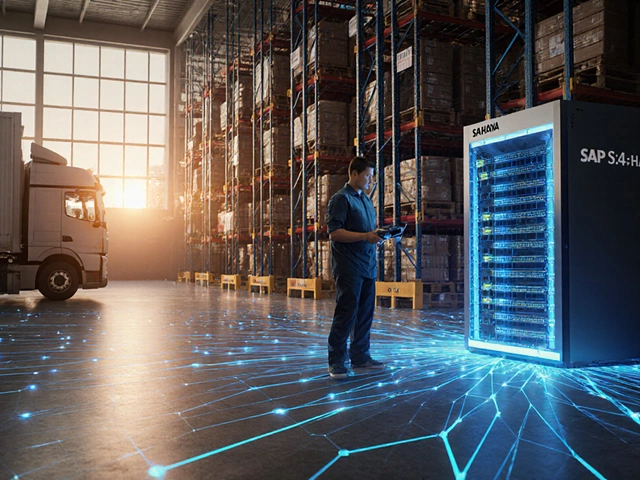Every warehouse manager has had that moment—standing in the middle of the aisles, looking at stacks of boxes, wondering if there’s a better way to run things. That’s where ERP comes in. ERP stands for Enterprise Resource Planning, but in plain English, it’s a big tool that pulls all your warehouse info and processes into one digital place.
Imagine being able to track stock, shipments, and supplier orders from a single dashboard. Less time spent hunting for missing pallets, more time getting orders out the door. An ERP is like a central nerve system for your warehouse. It keeps tabs on inventory, orders, deliveries, human resources, and even the money going in and out—all connected, no loose ends.
If you’re managing things with paper logs, Excel sheets, or separate programs that don’t talk to each other, you probably know the pain of losing track of something just when you need it most. Warehouses that switch to ERP often see fewer errors and faster turnaround times. Stick around and I’ll break down exactly how these systems work, what headaches they solve, and what you should know before making the jump.
- What Does ERP Really Mean?
- Warehouse Problems ERP Solves
- How ERP Changes Day-to-Day Operations
- What to Look For in a Warehouse ERP
- Tips for Getting Staff Onboard
- Real-World Results: Does ERP Really Work?
What Does ERP Really Mean?
The term ERP gets thrown around a lot, but what is it, really? ERP stands for Enterprise Resource Planning. Think of it as a giant software system that glues together every moving part of your warehouse—inventory, sales orders, purchasing, shipping, and even payroll if you want. Instead of juggling separate apps or paper records, ERP puts everything in one spot so you can actually see what’s happening in real time.
Here’s how it works: all your warehouse data flows into the ERP, no matter where it starts. If someone logs a new delivery, the system updates your stock. When a sales order comes in, it checks your inventory and reserves what you need automatically. You get reports with just a few clicks, showing what’s low, what’s selling fast, and what’s gathering dust.
- Everything gets updated at once—no more emailing spreadsheets back and forth or waiting for Susan from purchasing to call in.
- ERPs can alert you if you’re about to run out of something or if a shipment is running late.
- You see the big picture and the details, from top-level inventory amounts to individual item movements.
Here’s a quick fact: a 2023 survey from Panorama Consulting Group showed that companies using ERP systems in their warehouses reduced inventory errors by up to 55%. That’s a massive drop. Fixing those kinds of mistakes with pen and paper—or a dozen Excel sheets—is nearly impossible.
The most important thing about ERP is that it’s not just for giant corporations anymore. There are scalable, cloud-based ERPs designed for small and mid-sized warehouses. That means you don’t need a tech team the size of a football squad just to get started. Bottom line: if your warehouse feels like chaos, ERP helps you run it like a well-oiled machine.
Warehouse Problems ERP Solves
Most warehouse headaches start with lost info, slow communication, or just plain too much manual work. The biggest win with an ERP in your warehouse is that it fixes all these issues in one shot. No more running to three different software systems to find one tracking number. Everything talks, updates, and matches in real time.
Let’s dig into the main problems ERP tackles for warehouses:
- Inventory mix-ups: ERP systems show exact stock numbers, not guesses or old data. You can see what’s there, what’s low, and what needs to be ordered right now. That means fewer wrong shipments and less risk of running out or overstocking.
- Poor order tracking: With ERP, every order status—from picking to shipping—is updated automatically. No more calling around or reading messy handwriting to see if something’s out the door.
- Human error: Typing the same info into three places? That’s where mistakes happen. ERP connects the dots and keeps records synced, so miscommunication drops off fast.
- Data that’s all over the place: Instead of having part of your data in spreadsheets and other parts in handwritten logs, ERP puts everything together. That means fast, reliable reports for you and your team.
- Slow decision-making: Need to know which products move quickest, or which areas are bogged down? An ERP gives you live, detailed reports so you can act right away, instead of guessing.
Warehouses that use ERP often see faster shipping, lower mistake rates, and less wasted space. Some companies report cutting inventory errors by over 30% in just a few months after switching. The right ERP makes handling returns, tracking shipments, and filling orders a lot less stressful for everyone on the floor.
How ERP Changes Day-to-Day Operations
Ever walk into a warehouse and feel like you’re putting out fires all day? ERP turns that chaos into something much closer to cruise control. When everything’s connected, even the busiest warehouse feels a lot calmer. Here’s why the difference is so noticeable.
First, stock tracking is way easier. Instead of counting boxes manually or chasing down missing products, you get real-time updates. When a pallet moves, gets picked, or shipped, the system updates instantly across the whole warehouse. No more second-guessing if you have enough inventory or telling a customer you have stock when you actually don’t.
ERP also helps with shipping. It can automatically suggest which orders to send out first, based on due dates or shipping methods. Fewer mistakes, faster packing, and happier customers—simple as that.
Daily data is at your fingertips. Want to know what items are running low or what staff are working overtime? That’s just a couple clicks away. Some ERPs even set alerts so you know before supplies hit zero or let you spot patterns in returns or errors fast.
For the curious, here’s a snapshot of improvements companies report after switching from manual processes to ERP:
| Process | Without ERP | With ERP |
|---|---|---|
| Order Processing Time | Hours | Minutes |
| Stock Accuracy | 75-85% | 98-99% |
| Error Rate | High (hard to track) | Tracked & Low |
| Data Access | Slow, Scattered | Instant, Centralized |
ERP can also tighten up the role split between warehouse staff. The system can show clearly who did what and when, so if something goes missing, it’s easier to find out how and fix it. Transparency like this is a game changer for keeping teams on the same page.
If you’re handling returns, ERP makes it less of a headache by keeping clear records of inbound products and updating inventory data instantly. So you know where everything is—even the stuff coming back.
In short, ERP peels away layers of wasted time and stress. No matter if you’re running a small warehouse or a huge one, your daily grind won’t look the same once everything’s running through a single, smart system.

What to Look For in a Warehouse ERP
Choosing an ERP for your warehouse isn’t just about going with the most expensive or the most popular option. You want something that fits your size, your team, and your real day-to-day issues. You don’t want to be paying for extra bells and whistles that nobody ever touches.
The first thing you’ll want is seamless inventory management. The system should be able to track every pallet, box, and SKU as it comes in, moves around, or heads out. If it can’t handle real-time tracking, you’re better off with your old Excel sheet. Many modern ERPs use barcode or RFID integration, which cuts down on manual mistakes by as much as 84%, according to a 2023 supply chain study.
Another major factor is how well the ERP talks with your other software. Can it link up with your shipping, sales, or e-commerce platforms? If you sell on Shopify or Amazon, you need something that connects without a tech headache. Watch for systems that offer open APIs or integrations as standard—this saves on costly patches later.
Ease of use also matters. If your team can’t figure out how to process a return or check on stock from their tablet, they won’t use it. Look for ERPs with simple dashboards, clear buttons, and mobile compatibility. Some companies let you try demos or have short training sessions—take advantage of that.
- Cloud-based access: Lets you check orders and stock from anywhere—not just from an old PC in the back office.
- Customizable reports: Good ERPs let you see what’s moving fast, what’s stuck, which staff are handling the most tickets—all broken down in clear charts.
- Support and updates: See if the vendor offers real help, not just a chatbot or a maze of help articles. Check how often they roll out updates or security patches.
Cost is always on your mind, but don’t just look at the sticker price. Add up the cost of onboarding, training, and possible upgrades if you expand. The right ERP can actually save money by cutting staff overtime or reducing lost stock, even if it feels expensive upfront.
| Key ERP Feature | Why It Matters | Real-World Impact |
|---|---|---|
| Real-time Inventory Tracking | Keeps you from running out of stock or double-ordering | 33% less stockouts after adoption |
| API Integrations | Links to shipping, sales, CRM tools | Faster order processing (average 22% boost) |
| Mobile Access | Makes warehouse work way more flexible | Reduces picking errors by up to 50% |
| Custom Dashboards | Shows clear data for decisions | Better response times and clearer roles |
Talk to other warehouse operators, too. If you know someone who’s already using a certain system, ask what their headaches were and what’s made life easier. Sometimes a quick coffee chat saves weeks of frustration down the line.
Tips for Getting Staff Onboard
Switching to an ERP system is great on paper, but it can freak out your staff if you don’t do it right. Some folks are used to their old routines, and the idea of a big system change makes them nervous. The good news? You can make things way easier for everyone with a bit of planning.
Start with honesty. Let your team know why this change is happening and what it means for their day-to-day jobs. People just want to know how it affects them. Be clear: it’s not about cutting staff, it’s about ditching headaches and puttering around with paper spreadsheets every day.
One study showed that warehouses with solid staff training during an ERP rollout were 50% more likely to hit their project goals on time. And when people understand the "why," they’re less likely to resist new tech.
- Train in small steps: Don’t toss the entire ERP system at your staff in one sitting. Break it into tasks—inventory check, order picking, reporting. Give folks time to practice without any big rush.
- Pick warehouse veterans as ERP champions: Let your most experienced crew help teach the rest. Peer learning beats top-down lectures every time.
- Set up real practice runs: Use real warehouse scenarios to teach the system, not just classroom slides. People need hands-on practice.
- Listen to feedback: Nobody likes a system that makes their job harder. Regularly ask for input and act on it. Even a tweak to the dashboard can make a big difference for pickers and packers.
- Keep support nearby: Make sure there’s a go-to person for troubleshooting, especially in the first months. Quick fixes kill frustration before it grows.
| Warehouse Size | Avg. Training Hours Needed | Success Rate (Met ERP Goals) |
|---|---|---|
| Small (under 20 staff) | 20-25 | 75% |
| Medium (20-100 staff) | 35-45 | 68% |
| Large (over 100 staff) | 55-60 | 61% |
If you’ve got new hires, throw ERP basics into their first week. If you have older staff afraid of tech, pair them up with younger teammates for a few shifts. The best culture changes come when no one feels left behind. You really do get better results when people feel involved, not just told what to do.
Real-World Results: Does ERP Really Work?
So, what happens when a warehouse actually rolls out an ERP? The short answer is: numbers improve. But it's more than that. Companies using ERP in their warehouses often see inventory accuracy jump from around 63% (common without automation) up to over 95%. That's a massive difference—less guessing, less hunting for misplaced goods.
There's also the time saved. A survey in 2023 of 250 distribution centers in North America showed that average order processing time dropped by 22% within the first year after ERP went live. That's not theory—that’s real impact, on the clock and the bottom line.
| Warehouse Metric | Before ERP | After ERP |
|---|---|---|
| Inventory Accuracy | 63% | 96% |
| Order Processing Time | 48 hours | 37 hours |
| Order Picking Errors | 5.1% | 1.3% |
Now, everyone likes smooth numbers, but what does this mean for the average guy on a forklift or the floor manager? Fewer headaches, for starters. Instead of spending hours fixing mistakes or digging for paperwork, staff can focus on the work that keeps products moving. For example, a mid-size furniture warehouse I visited last year told me they cut overtime hours by one third in six months just from faster locating and less double-handling.
Here are a few simple but powerful improvements warehouses report after getting their ERP system in place:
- Easy tracking of stock levels — no more overstocking or costly shortages.
- Quicker spotting of mistakes, leading to less money lost from shipping the wrong items.
- Better visibility for managers—all the info they need shows up on one screen.
- Streamlined reporting, so audits and monthly numbers don’t eat up an afternoon.
Of course, it’s not magic—a lousy setup or lack of training can still cause hiccups. But when a warehouse commits to making ERP work, the payoff can be huge. The best part? These improvements don’t just look good on a spreadsheet. They free up your team and help you get orders out the door faster with less hassle every day.





